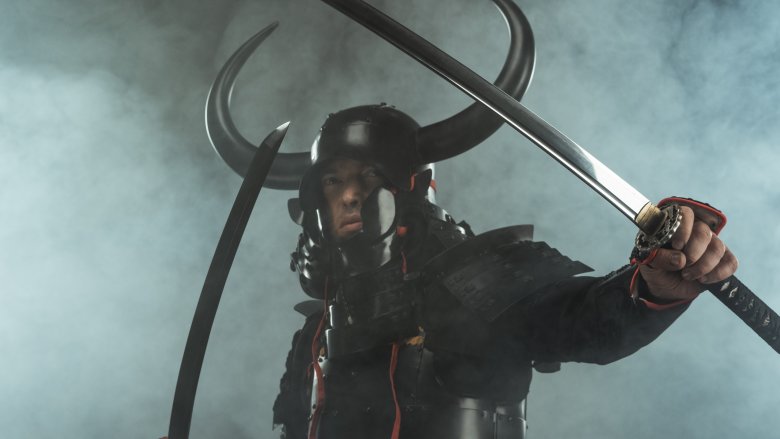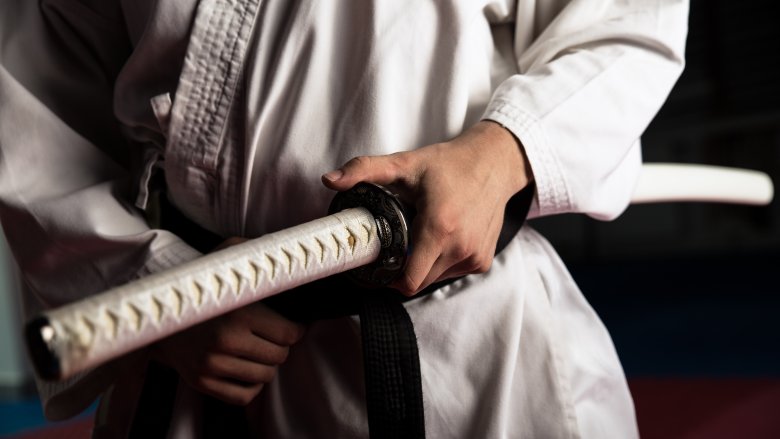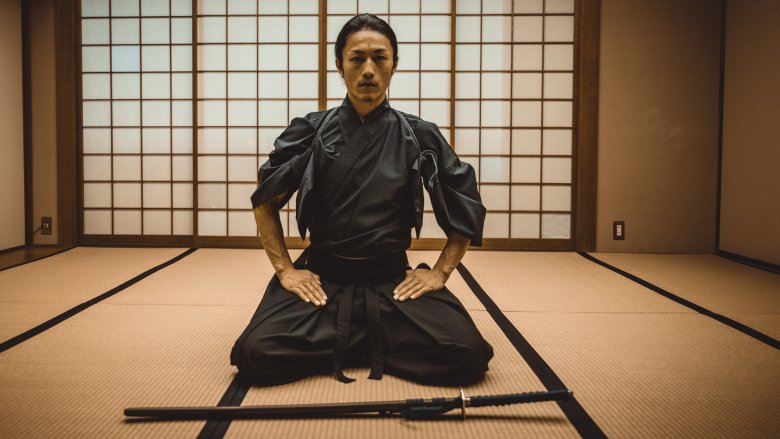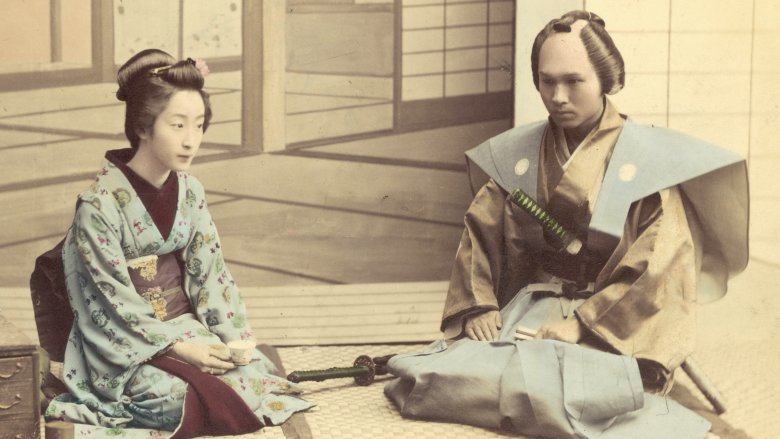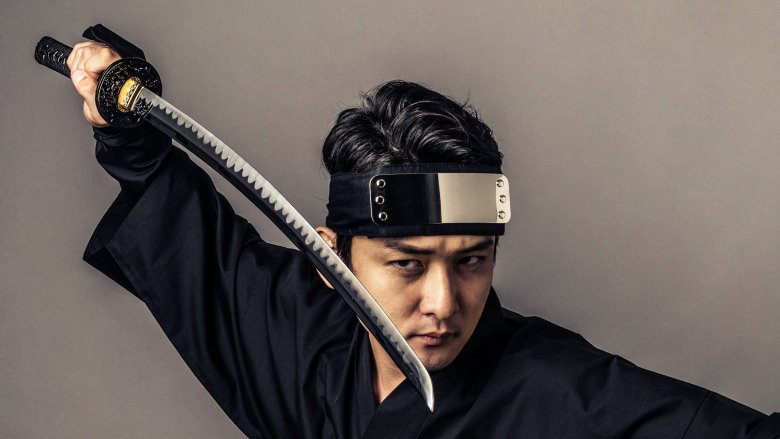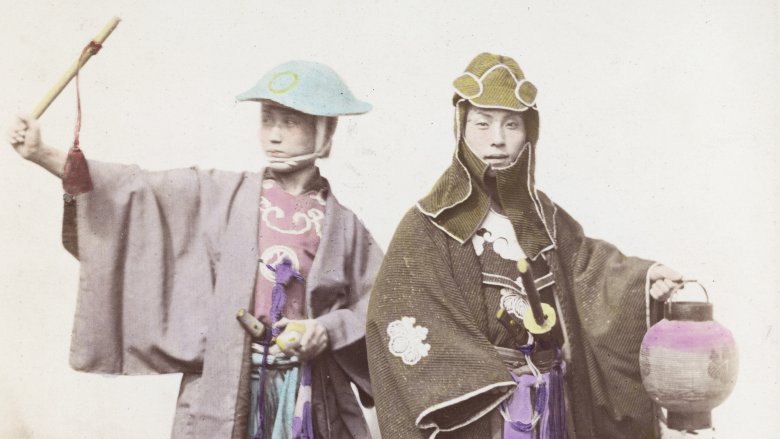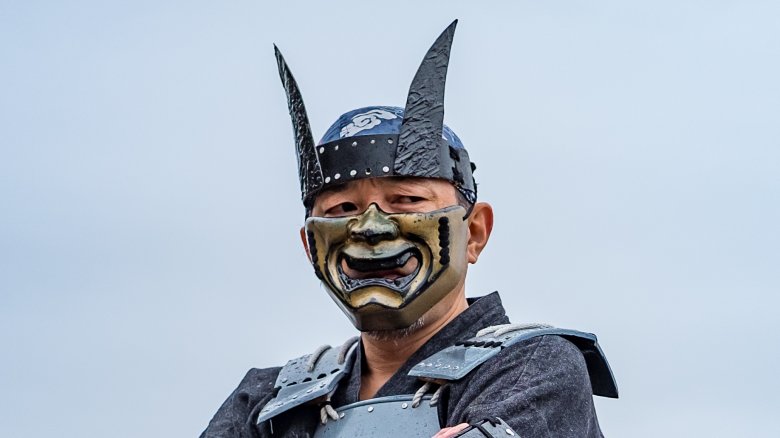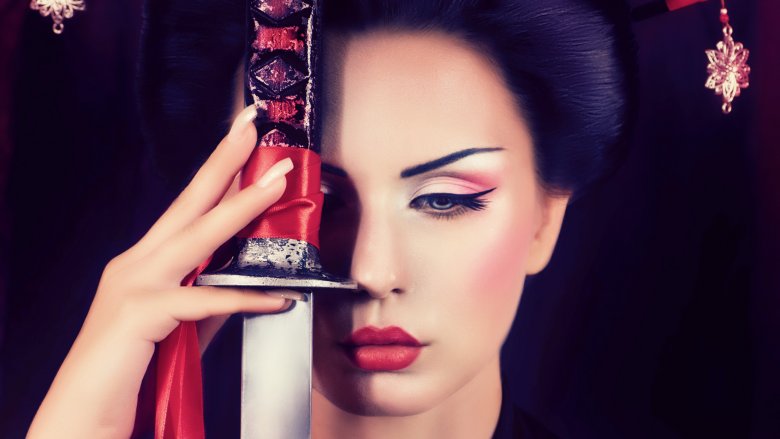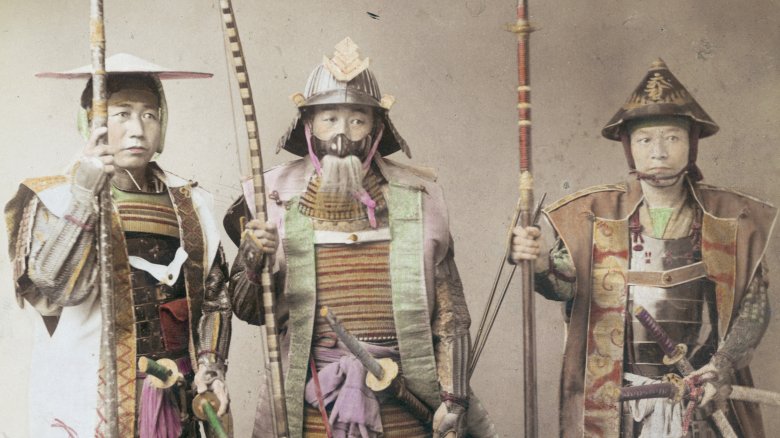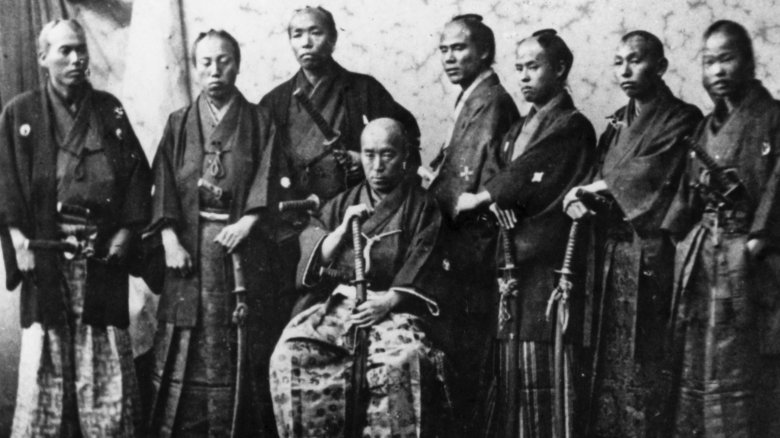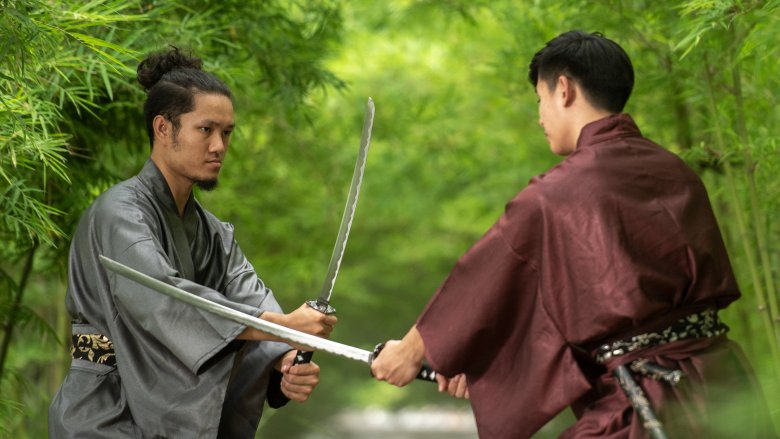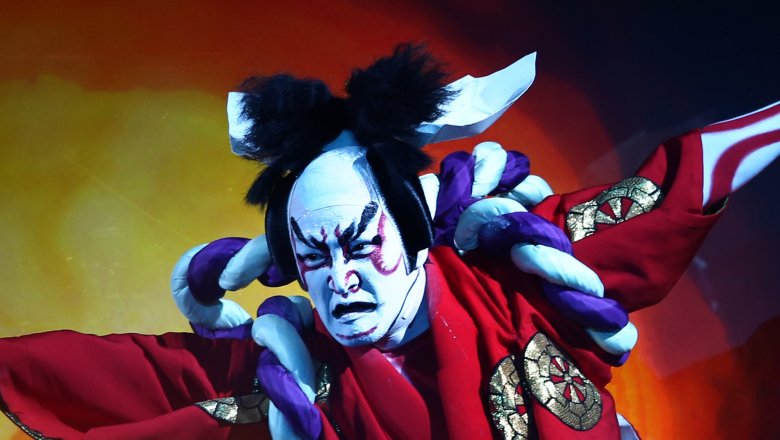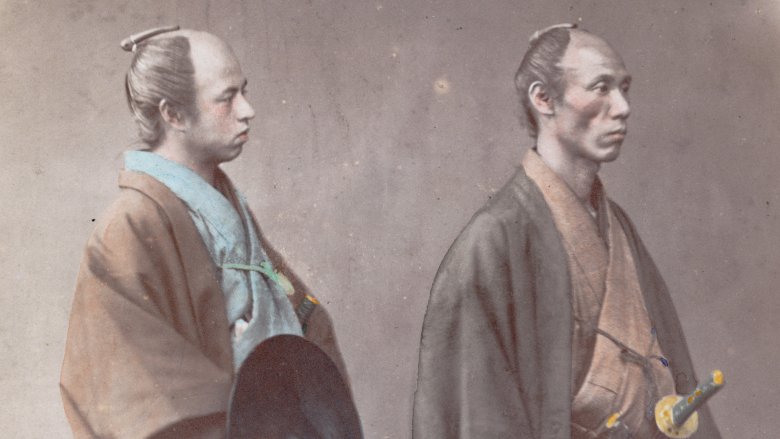Messed Up Things You Didn't Know About The Samurai
Ah, the samurai! These fine purveyors of honorable actions and sword-based mayhem are one of the most famous symbols of Japan's history, and a huge source of pride for the country. As one of the most legendary warrior classes in history, samurai are a staple of pop culture and high culture alike, and countless works have been devoted to their amazing escapades. This means that even the most casual observer has at least some idea of what the samurai were all about, and how their bravery, skill, and unshakeable moral convictions were more than enough to vanquish any enemy foolish enough to come their way.
And, in a way, that's precisely the problem. That vague idea of the stoic, right-minded samurai warrior is so deeply ingrained in our brains that it's easy to forget they were people just like everyone else, and as such had plenty of less-than-desirable qualities, practices, and traditions. In fact, the life of your average samurai could be surprisingly messed up in a whole lot of ways. Let's take a look at some of the most surprising ones.
Secrets of samurai seppuku
Seppuku, as History explains, is a ritualistic suicide method where a samurai slices his stomach open with a small sword. Ever since it emerged in the 12th century as an honorable method for losing samurai to die on the battlefield, Japan has wrought all sorts of abdominal-slicing doom upon its elite warrior class. According to ThoughtCo, there were two basic ways of doing the deed. The more awful variation, jumonji giri, had the performer cut his abdomen open with a vertical and a horizontal cut, then wait for death in excruciating pain. However, most opted for the softer variant, where a helper known as kaishakunin decapitated them immediately after the first cut.
Outside the battlefield, seppuku was an elaborate process, where the participants made a day out of it with rituals such as the writing of a "death poem" and having a good drink of sake before grabbing the blade. Usually, there were even spectators present. Samurai warriors could perform seppuku as a political protest, or to show their overwhelming grief over the death of a beloved leader. It was also a form of death sentence: Shoguns and daimyos could command their underlings to perform seppuku for "real or perceived" slights, at which point the person had to follow through, lest he bring shame to himself and his entire family.
If you or anyone you know is having suicidal thoughts, please call the National Suicide Prevention Lifeline at 1-800-273-TALK (8255).
Samurai bushido as we know it is a modern creation
Bushido code is one of the first things many people associate with the noble samurai, but is it really what we think it is? Not quite, according to Dr. Henry Smith of Columbia University. The original bushido was just one of the assorted warrior guidelines in Japan's history, such as tsuwamono no michi, samuraido, and bushi no michi. Their values often included things like fighting spirit, skill, duty, honor, loyalty, and self-sacrifice, but focused on different things and were by their very nature pretty martial.
Since bushido is the one we know today, surely it was just the code that won some sort of samurai ethics tournament to become the one everyone started to follow? According to Dr. Smith, again, nope. When the Meiji Restoration of 1868 ended the Edo period and essentially abolished the samurai class, samurai warrior values steered the loyalty aspect from the samurai's immediate master to a more generalized appreciation of the emperor and nation, and in the case of the country's Christians, even Jesus.
Nitobe Inazô's 1899 book Bushido: The Soul of Japan is arguably the most influential description of this reimagined bushido in modern Japan, which is ironic because Nitobe's book was aimed at Western readers and retooled bushido as a largely non-militaristic take on Western chivalry. Instead of samurai, Nitobe's bushido is for everyone in the Japanese society and focuses on the positive aspects of a loyal, humble, brave, and hard-working citizen.
Forced samurai marriages
As Japan Guide notes, the samurai really started flourishing during the Edo Period (1603-1867), when they rose to the upper echelons of Japan's society and became the highest caste. However, their higher-than-ever social status didn't mean they were free to do whatever they felt like, at least when it came to marriage. According to Hisako Hata, curator of the Edo-Tokyo museum, marriages of the Edo era were generally prearranged, and young members of the samurai class had it particularly bad: Apart from having their parents essentially choose them a spouse from whatever family was deemed socially appropriate, they also needed "the consent of domainal and shogunal authorities" before they could marry that person who, to them, was often a virtual stranger they had no real feelings for.
This system made love marriages extremely rare, but that didn't mean people didn't still fall in love with ... someone. As a result, some young, desperate lovers would commit suicide together when it became evident that their parents had other plans for their marital future.
If you or anyone you know is having suicidal thoughts, please call the National Suicide Prevention Lifeline at 1-800-273-TALK (8255).
Gruesome weapon tests
Katana swords are at least as cool and legendary as their historical samurai wielders, and they've held a lot of ceremonial sway over the years. However, a katana is still a sword, which means it had to be tested before the swordsmith presented it to its samurai owner. According to Vintage News, the testing was an elaborate process called tameshigiri ("test cut"). This put both the sword and its user's skill to the test by cutting into materials such as bamboo, wood, or armor, and if either the katana or the man swinging it weren't up to the task, the sword could quite easily be ruined.
Tameshigiri is still practiced today, but its dark subsection known as suemonogiri has hopefully gone the way of the dodo. Suemonogiri means "the cutting of tied objects," and said objects were actual human bodies. The bodies were usually those of dead criminals (though live subjects were used on occasion), but using corpses didn't make the process any less gruesome, especially as the mutilation count was sometimes inscribed on the sword as a creepy seal of quality. Kazuhiro Sakaue of Japan's National Museum of Nature and Science writes that the cut test cadavers could be stacked up to seven bodies high, and they were sometimes so badly mutilated that the families of tameshigiri subjects sneaking up to recover the remains could accidentally end up burying a Frankenstein body, hastily cobbled together from indistinguishable bits in the multiple-corpse test pile.
Samurai poverty
Apart from the masterless ronin drifters, the samurai class isn't usually associated with poverty. However, the fact that they were at the top of feudal Japan's food pyramid didn't necessarily mean they controlled vast amounts of wealth. According to Japan Times, the Tokugawa shoguns of the Edo Period (1603-1867) felt that what they called danihoshoku ("warm clothing and plenty of food") would be detrimental to the society, and started pushing toward stoic attitudes in all Japanese classes. This push was so effective that many Japanese either couldn't understand or tried to avoid money, and the samurai in particular took Tokugawa tenets to heart, to the point that they started seeing money as too "tainted" to mess with.
Historian Kozo Yamamura writes that most scholars agree on the increasing poverty among the samurai during this era, but the actual extent of their supposed squalor is largely unclear and may have been influenced by the modern image of the humble, noble samurai. Yamamura doesn't outright debunk the concept of the impoverished Edo samurai but notes that the "increasing poverty" could have been due to any number of economic reasons, from other classes' wealth rising faster than that of the samurai class to "psychological poverty," where the samurai grew so accustomed to their power and wealth that their expectations for income rose higher than their actual income.
The samurai often participated in ruthless roadside killings
One of the most terrifying traditions associated with the samurai was tsujigiri. As Carla Sinclair of Tofugu explains, the term means "roadside killing," and there's absolutely no hyperbole in that name. Though the practice had its roots in honorable dueling, it eventually twisted into a popular practice where members of the samurai class sneaked around to unexpectedly slash at passing merchants and peasants. Sometimes, there were vague excuses for these gruesome slayings, such as testing out a new weapon or practicing a strike. Other times, it was done simply because the samurai just happened to feel like it. There was even a legend floating around that performing 1,000 tsujigiri killings could cure illness. All in all, it was not a great time to walk out at night if you were a merchant or peasant.
Encyclopedia of Japanese Swords says that tsujigiri ultimately became such a massive problem that the newly empowered Tokugawa officials prohibited it in 1602. Even then, the custom didn't exactly go away overnight. Regular instances of tsujigiri were reported well into the Edo period, to the point that even the third Tokugawa shogun, Iemitsu, was rumored to often sneak out of the Edo castle to chop up passersby on the dark streets of his city.
The grim fate of samurai wives
Most people are familiar with seppuku, the traditional samurai suicide method. However, as Japan Info tells us, there's another, less famous method called jigai. It wasn't for the samurai himself, but for the female members of his family. It focused on swiftness and dignity instead of honor and pain tolerance, so instead of bringing a blade to their midsection, the woman would slice her own throat. Often, she would also tie her knees together so she wouldn't be discovered in a compromising position.
There were many reasons women of samurai families would perform jigai, from atonement for bringing shame to her family to preserving her honor in the event of an enemy invasion. However, it was most commonly practiced by wives whose husbands had committed seppuku. In other words, a samurai's wife felt it necessary to ritually kill herself if her husband had messed up in some way.
If you or anyone you know is having suicidal thoughts, please call the National Suicide Prevention Lifeline at 1-800-273-TALK (8255).
The last stand of the samurai
All things must come to an end, and HistoryNet says Japan's feudal system sang its swan song on a battlefield near Kagoshima on September 25, 1877. The country had been moving toward modern times, aided in no small part by none-too-subtle hints from the superior military might of the U.S. Traditional samurai had resisted change because it stripped them of their previous power, and there had been several unsuccessful revolts. Now only the Satsuma clan samurai and their leader Takamori Saigo remained, and Saigo's initial attempts at peaceful negotiations with the government had descended into violence. This was a problem because the government had sent 30,000 soldiers to face him. Saigo had 500 men who were so short on supplies that they had to melt trinkets into bullets, and their only medical supplies were a carpenter's saw and some rags. Saigo himself lived in a small hole dug in a hillside.
As the imperial army was hammering his positions with lethal artillery fire, Saigo resigned himself to his fate and had a final sake party with his closest friends. Early in the morning of September 25, the imperials stormed the samurai positions. Three hours later, only 40 of Saigo's men were alive and the samurai leader himself was mortally wounded. Saigo had his follower Shinsuke Beppu take him to an appropriately nice hilltop spot and behead him. After this, Beppu and the remaining samurai drew their swords and charged the enemy gunfire. None survived.
Wakashudo
As All About Japan notes, the samurai were surprisingly open-minded about same-sex relationships, which is pretty great. Arguably less great, however, is that they went about this with a system called wakashudo, where younger men were required to become "wakashu" — basically a combination of trainees and field wives for older warriors. The older man, in turn, would mentor, train, guide, and protect the wakashu until the young man finished this "apprenticeship" and moved into the ranks of the warriors.
According to James Neill's book The Origins and Role of Same-Sex Relations in Human Societies, the role of wakashu had its roots in Buddhism, and it was not entirely voluntary: Youths were encouraged to embrace the wakashu role with teachings and sayings that heavily insinuated that a handsome youth who refused to yield to an older lover was acting shamefully. This, in turn, would greatly hurt the wakashu's karma, to the point that they risked a physical deformity in their next life. Fear is a powerful thing.
The samurai were legally allowed to kill insulting people
Nowadays we talk about adding insult to injury, but the samurai liked to approach this concept the other way around. As the Encyclopedia of Japanese Swords tells us, a practice known as kirisute-gomen — "authorization to cut and leave (the body of the victim)" — allowed them to legally kill people who they felt were disrespecting them, as long as they did it immediately after the supposed insult happened and the victim was of a lower social class. The insult and retaliation needed to be seen by a witness who could recount the events in front of a court, though the samurai were allowed to use their own servants and friends as witnesses.
While this may seem like every samurai had carte blanche to kill almost any merchant or peasant who as much as looked at them in a funny way, there were also serious repercussions for anyone caught abusing this system. A samurai who was found to misuse his kirisute-gomen privileges was given a "severe" punishment, which could be a shameful death by beheading (as opposed to the more honorable seppuku), and his house being abolished so his sons could not inherit his title and position. Ouch.
Strange street gangs
What does a warrior do during a period of peace? Well, if he's a samurai, he might start wearing outlandish clothing, get a rebel haircut, and join a themed street gang to terrorize common folks and clash with other gangs like in the movie Warriors. According to Taiho-Jutsu: Law and Order in the Age of the Samurai, the lack of respect and also the lack of wars to fight drove some bored and unemployed Edo-period samurai out on the streets, where they joined with other highborn kids to form strange gangs such as the kabukimono and the kyokaku.
Kabukimono were a flamboyant group that eschewed traditional samurai behavior in favor of strange clothes, deliberately debauched behavior, and strange slang. Their behavior was that of a stereotypical 1980s movie gang, in that they roamed the streets harassing townspeople, wreaking havoc, and brawling with other gangs. Kyokaku ("street knights") were one of those other gangs and the natural enemy of the kabukimono. They were vigilantes who were comprised of samurai and lower-class townspeople alike, and were nominally protecting the people. The kyokaku carried extra-long swords, shaved their traditional sideburns all the way up to the temple, and marked their allegiance with expensive fabrics worn draped over the shoulder or as neckerchiefs. Cool and mysterious as their vigilante antics might have seemed, kyokaku were basically just another group of street thugs, and the violent clashes between them, kabukimono, and other factions provided the Edo period with a hefty helping of bloody gang violence.
The Meiji restoration
Everything must end eventually, and as Japan Times attests, the samurai faced the music during a period known as Meiji restoration. When the last Tokugawa shogun died in 1853 with no follower in sight, Japan plunged into a long period of turmoil that destroyed the shogunate and gave rise to Emperor Meiji, who took the throne in 1868. Meiji's government started steering the country toward modern times by opening up to industrialization and Western influences ... and stripping away the samurais' powers.
The Meiji restoration left an estimated two-thirds (over 2 million people, or about 6% of the total population) of the samurai class without a job. The remaining samurai were somewhat more fortunate, as they were hired in new bureaucratic positions and found a new purpose as facilitators of Japan's social change.
